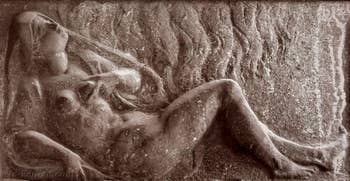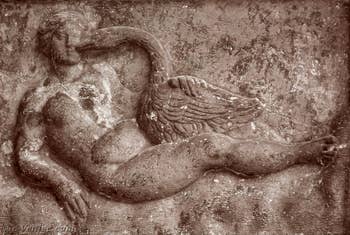History Important dates | Politics | Navy | Love | Wars | Religion | Scuole | Ghetto | Printing
Love Giorgio Baffo | Casini Casins | Cicisbeo
The Cicsbeos, being Cicsbeo in Venice

Erotic sculpture in Venice At that time, female mortality was high during childbirth. As a result, many noblemen and wealthy merchants often married very young women in second or third marriages, as the others were already married...
This posed a simple physiological problem, given the age difference: in a city as liberal as Venice in terms of morals, the young lady had every opportunity to find pleasure elsewhere than in the arms of her old husband.
This is how the practice of Cicsbeo became commonplace and totally tolerated
Most often, the Cicsbeo was housed in the apartment above that of the legitimate couple.
The husband, a willing cuckold, could thus ensure that at least his wife had only one lover, one gallant, who also watched over her on behalf of the husband.
The neighbours were not fooled and everyone was very satisfied with this arrangement, including, as one might expect, the young wife!
This is how Jérôme de La Lande described it in 1765:
« The custom of cicisbeos (Cicsbeos) or Cavalieri Servanti (knights servants), so common in Venice among people of quality, led an English man to say that most girls in Venice marry not for love of the husband they choose, but for the freedom to live without constraint with their Cavaliere Servante. »
Jérôme de La Lande in 1765
As Monier says in his book on Venice in the 18th century:

Leda and the Swan
« In Venice, all women have a Cicsbeo. Even the shopkeeper and even the hairdresser, if we are to believe Abbot Chiari. They would rather go without bread than without a gentleman.
And when they are of high standing, they have several around them. And it is perhaps the presence of this friend that gives them such audacity. Without him, they would be less cheerful, and they would wear out their shoes less.
For we read in the Diario Veneto that one of them, barely two months married, used, to the great astonishment of her parents and especially her husband, "seven pairs of shoes and two pairs of boots, without having been to any ball, or even to the countryside." »
Monier - Venice in the 18th century
But the most beautiful account of the Cicsbeos (here Genoese, as the Venetian fashion had apparently been exported...) is given to us by Ange Goudar
« Duties of a Cicsbeo
I. The Cicsbeo must go to his Lady every morning, at precisely nine o'clock, to serve her chocolate or coffee in bed himself.
II. Upon entering her room, he must take care to open the windows, so that when he embraces the Lady in her bed, he can see what he is doing.
III. If the Lady asks him for a pin to fasten her chemise at the top to hide her throat, he shall search everywhere in the apartment for one; and even if there are two or three thousand on her dressing table, he shall take care not to find a single one.
IV. If her daughters (servants) are not in her room when she wants to get up, the Cicsbeo shall not withdraw, but shall help her to dress.
V. While attending to her toilet, he shall stand behind her like a servant, so as to be within reach of giving her all the necessary ingredients that go into the composition of a Genoese face. He shall present to her in turn the white, the red, the fly box, the lip balm, without confusing any of the beauty utensils.
VI. When she is ready, he shall give her his hand to lead her to her sedan chair, and shall go with her to mass, walking in front of or beside the chair like a footman : in this way he shall precede the bearers and arrive breathless at the door of the church, to offer her holy water. VII. In the evening, he shall take her to the theatre, where he shall sit beside her. VIII. In winter, he shall give her his stocking and place it himself under her skirts, etc. And there are many other instructions on how to use Cicsbeo, but these are secret, and Genoese husbands must pretend to be unaware of them. »
Ange Goudar - The Chinese Spy 1765
But one should not imagine that the life of Cicsbeo was all happiness and pleasure, and if we are to believe the analysis of Molmenti, the Cicsbeos actually became a kind of sexual slave to Venetian ladies...
Where sincere love was lacking, the husband was replaced by the Cicsbeo. The gallantry of women had, as we have said, its sweetness and charm; but Cicsbeism was a profession, an ignoble passion formed of negative and unmanly qualities.
When fashion, at the beginning of the 17th century, dictated that domestic affections should not be displayed in public, the Cavalieri serventi were invented, and were often even required in marriage contracts.
This institution was perhaps harmless at first, but it was bound to go too far.
It was not long before the Cicsbeos appeared, whose secret confidants were gondoliers and maids.
The Cicsbeos, martyrs of gallantry, slaves to the fair sex, as nervous as they were, swooned with love, guessed the slightest desires of their ladies in order to satisfy them, accompanied them to conservatories or theatres to applaud some singer or famous actress, and even to church to hear Mass or a famous preacher. »
Molmenti
Love Giorgio Baffo | Casini Casins | Cicisbeo
History Important dates | Politics | Navy | Love | Wars | Religion | Scuole | Ghetto | Printing
Back to Top of Page

